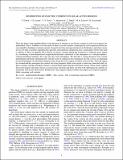Files in this item
Distribution of electric currents in solar active regions
Item metadata
| dc.contributor.author | Török, T. | |
| dc.contributor.author | Leake, J.E. | |
| dc.contributor.author | Titov, V.S. | |
| dc.contributor.author | Archontis, V. | |
| dc.contributor.author | Mikić, Z. | |
| dc.contributor.author | Linton, M.G. | |
| dc.contributor.author | Dalmasse, K. | |
| dc.contributor.author | Aulanier, G. | |
| dc.contributor.author | Kliem, B. | |
| dc.date.accessioned | 2014-09-02T10:01:04Z | |
| dc.date.available | 2014-09-02T10:01:04Z | |
| dc.date.issued | 2014-02-10 | |
| dc.identifier | 145270709 | |
| dc.identifier | dfaa9c3b-da8e-4d7e-a9f6-291e561aadeb | |
| dc.identifier | 84893418550 | |
| dc.identifier | 000331149900010 | |
| dc.identifier.citation | Török , T , Leake , J E , Titov , V S , Archontis , V , Mikić , Z , Linton , M G , Dalmasse , K , Aulanier , G & Kliem , B 2014 , ' Distribution of electric currents in solar active regions ' , Astrophysical Journal Letters , vol. 782 , no. 1 , L10 . https://doi.org/10.1088/2041-8205/782/1/L10 | en |
| dc.identifier.issn | 2041-8205 | |
| dc.identifier.other | ORCID: /0000-0002-6926-8676/work/73700864 | |
| dc.identifier.uri | https://hdl.handle.net/10023/5322 | |
| dc.description | The contributions of T.T., V.S.T., and Z.M. were supported by NASA's HTP, LWS, and SR&T programs. J.E.L and M.G.L. were supported by NASA/LWS. M.G.L. received support also from the ONR 6.1 program. The simulation was performed under grant of computer time from the D.o.D. HPC Program. B.K. was supported by the DFG. V.A. acknowledges support through the IEF-272549 grant. | en |
| dc.description.abstract | There has been a long-standing debate on the question of whether or not electric currents in solar active regions are neutralized. That is, whether or not the main (or direct) coronal currents connecting the active region polarities are surrounded by shielding (or return) currents of equal total value and opposite direction. Both theory and observations are not yet fully conclusive regarding this question, and numerical simulations have, surprisingly, barely been used to address it. Here we quantify the evolution of electric currents during the formation of a bipolar active region by considering a three-dimensional magnetohydrodynamic simulation of the emergence of a sub-photospheric, current-neutralized magnetic flux rope into the solar atmosphere. We find that a strong deviation from current neutralization develops simultaneously with the onset of significant flux emergence into the corona, accompanied by the development of substantial magnetic shear along the active region's polarity inversion line. After the region has formed and flux emergence has ceased, the strong magnetic fields in the region's center are connected solely by direct currents, and the total direct current is several times larger than the total return current. These results suggest that active regions, the main sources of coronal mass ejections and flares, are born with substantial net currents, in agreement with recent observations. Furthermore, they support eruption models that employ pre-eruption magnetic fields containing such currents. | |
| dc.format.extent | 6 | |
| dc.format.extent | 1482548 | |
| dc.language.iso | eng | |
| dc.relation.ispartof | Astrophysical Journal Letters | en |
| dc.subject | Magnetohydrodynamics (MHD) | en |
| dc.subject | Sun: corona | en |
| dc.subject | Sun: coronal mass ejections (CMEs) | en |
| dc.subject | QB Astronomy | en |
| dc.subject | QC Physics | en |
| dc.subject.lcc | QB | en |
| dc.subject.lcc | QC | en |
| dc.title | Distribution of electric currents in solar active regions | en |
| dc.type | Journal article | en |
| dc.contributor.institution | University of St Andrews. Applied Mathematics | en |
| dc.identifier.doi | 10.1088/2041-8205/782/1/L10 | |
| dc.description.status | Peer reviewed | en |
This item appears in the following Collection(s)
Items in the St Andrews Research Repository are protected by copyright, with all rights reserved, unless otherwise indicated.

